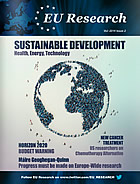Archive for December 2011
Photosynthetic proteins for technological applications: biosensors and biochips (PHOTOTECH)
By converting solar energy into chemical energy, photosynthesis supports basically all life on Earth. Key to this process is the use of light energy to power electron transfer across a charge-impermeable lipid membrane. In recent years it has been shown that the nanoscale photosynthetic pigment-protein complexes that catalyse this reaction can be isolated from the native organism in a stable form and interfaced with a conducting metal or carbon electrode surface. The activity of these proteins when integrated with non-biological electronic components can be monitored through their highly distinctive absorbance and fluorescence properties, and through the measurement of light-induced photocurrents. In addition the structure and composition of these structurally-characterised proteins can be altered through genetic engineering. These properties can be exploited for the construction of optoelectronic devices and mono- and/or multi-molecular layers of either natural or engineered proteins for the development of commercial biosensors and biochips.
The objective is to explore, interface and merge the various aspects of the development of photosynthetic proteins-based biodevices with a focus on biosensors, that provide a complementary innovative tool with respect to traditional analytical chemical methods. The purpose will be the creation of a new research platform for the Design and Production of Bioelectronic Devices by networking researchers and professionals that can combine and integrate diverse disciplines. The main outcome of this COST Action is the co-development of a fully characterized class of bio-organic-inorganic hybrid biosensors to be first applied in environmental monitoring and agrofood quality analysis.
(From the cost.eu website : http://www.cost.eu)
The objectives of the PHOTOTECH COST Action are:
- Sustainable European network in the field of photosynthesis-based biosensors (established training network, new collaborative projects, high level scientific publications).
- Deepen knowledge on charge separation and electron transfer phenomena in RC proteins either in the native form or interfaced with inorganic-organic materials, improving understanding of the nature of the interactions
- Laying a foundation for future development of bio-hybrid
- Exploring the power of molecular biology and bioinformatics as tools to improve the performance of photosynthetic complexes as biomediators.
- Demonstrating the capability of keeping the proper functionality of the biomediators in a hostile environment, such as solid-state devices.
- Delivering robust, reliable, environmental-friendly and sensitive biosensor prototypes.
- Promoting EU mobility among early-stage researchers.
- Contributing to technology transfer (TT) to EU industrial networks and innovation/TT offices.
The research tasks to be coordinated by PHOTOTECH concern Molecular Biology and Biochemistry, Biotechnology, Bioinformatics, Organic and Inorganic Chemistry, Nanotechnology and Device Engineering and Prototyping:
Task 1: Identification and selection of the most suitable photosynthetic biorecognition elements (whole cells and photosynthetic active sub-components) and of the best transduction mechanism for coupling to each different biomediator.
Task 2: Design and application of bioinformatic and molecular biology strategies to improve bioreceptor properties: stability (robustness), electrical (electron transfer), optical (fluorescence emission), chemical (adhesion, linkage) and sensing (specificity, sensitivity, , lifetime).
Task 3: Explore several immobilization techniques and protocols to synergistically integrate the advantages of the biological material and living organisms with the advantages of organic and inorganic materials (robustness, reproducibility, stability, good electrical contact to macro-structures, good adhesion): layer-by-layer, in-situ, dry methods.
Task 4: Design and fabricate stand-alone biosensor prototypes integrating the required electronics for signal processing, the mechanical structures to host the bio-hybrid component and/or the sample under test, the fluidic architecture for complete automation and simple use.
Task 5: Define testing and characterization procedures and techniques to optimize the measurement and validation of each assembled biohybrid structure and device down to single component elements.

